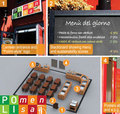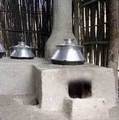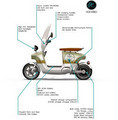TED: Greg Asner: Ecology from the air - Greg Asner (2013)
by: TEDTalks (video), 2013-11-19 16:00:54 UTC
What are our forests really made of? From the air, ecologist Greg Asner uses a spectrometer and high-powered lasers to map nature in meticulous kaleidoscopic 3D detail -- what he calls “a very high-tech accounting system” of carbon. In this fascinating talk, Asner gives a clear message: To save our ecosystems, we need more data, gathered in new ways.
 Grid-Tied Renewables Savings Outweigh Costs
Grid-Tied Renewables Savings Outweigh Costs
by: Eco Geek Latest, 2013-11-08 03:54:58 UTC

The additional costs associated with adopting renewable energy are frequently used to argue that it is too expensive to adopt renewables. However, the National Renewable Energy Laboratory has taken a look at the costs and offsets from renewable energy use and finds "The answer: the cost is a tiny fraction of the ultimate savings."
Although the costs for the equipment needed to integrate renewables into the existing grid are not insignificant, the associated savings in reduced fuel costs are far greater. Cycling fossil power plants to generate power intermittently also increases wear on the equipment, which leads to increased maintenance costs. But overall, the savings are far more than the increases.
The other key finding is that, as renewables continue to be integrated into the grid, the continuing costs will become smaller. Making the systems able to work with renewables connected to the grid is something that gets easier and less expensive. So, in a way, the early adopters have made an even bigger contribution to improving the energy infrastructure.
via: Ars Technica
 At This Austrian Pop-Up Restaurant, You Can Exchange Garbage For Food
At This Austrian Pop-Up Restaurant, You Can Exchange Garbage For Food
by: Co.Exist, 2013-11-27 14:16:00 UTC
Waste has value, and Biomat took that literally.
Vera Wiedermann set up Biomat, a restaurant where you can exchange your waste for fresh food, basically to get people's attention.
Read Full Story






 Craft of Use
Craft of Use
by: Centre for Sustainable Fashion, 2013-11-25 09:57:15 UTC

Just because you own it, doesn’t mean you know how to use it…
This week the CSF online discussions are dedicated to the celebration of the craft of use! While most of us probably know what ‘craft’ is in a production context – the actions and outputs of highly skilled creative makers drawing upon techniques they have developed over time – thinking about craft in the context of using things is an altogether much less familiar prospect. Yet we believe that those same cultivated actions and distinguished, innovative outputs can also occur as people use their ‘stuff’. We have been exploring what this means for fashion through research called Craft of Use, linked to the Local Wisdom project.
The craft of use is a set of practical skills associated with tending and using fashion, it is also a habit of mind that affects our engagement with the material world and our passage through it. The ideas’ motivation is tied to themes of resource scarcity and flourishing: of living well – and more than that – of thriving, within limits. We think that we need to put as much attention into using things as creating them. Then opportunities for novel fashion provision and expression will be met by a kinetic and evolving engagement with using garments rather than consumption of new clothes.
We see the actions of the craft of use as a set of practices that combine us as individuals, our bodies, minds, garments, stories and skills. More on these can be found at the craft of use site and will be the subject of a day-long special event in London in March 2014.
Kate Fletcher and Katelyn Toth-Fejel

Sustainability Jobs 101: Landing a Creative Career
by: Triple Pundit: People, Planet, Profit, 2013-11-29 09:00:41 UTC
Sainsbury’s Opens ‘Triple-Zero’ Stores
by: Environmental Leader, 2013-11-27 15:49:04 UTC

Sainsbury’s supermarket in Leicester, which opens today, is one of two “triple-zero” stores the retailer has just opened. It emits zero CO2 from all operational energy used, zero waste goes to landfill, and the store has zero impact on the water usage of the local catchment area because of its “water-neutral” status, the UK grocery […]
 Supply Chain Sustainability: What It Really Means to ‘Go Green’
Supply Chain Sustainability: What It Really Means to ‘Go Green’
by: Environmental Leader, 2013-11-27 16:35:12 UTC

A look at how sustainability can be incorporated into the supply chain through a closer look at one of the company’s latest solutions Sustainability is a hot topic in the food and beverage industry. As manufacturers seek to reduce costs and maintain customer loyalty, implementing sustainable practices can help to achieve these aims while at […]
 fuseproject diagnoses illness + treatment with kernel of life
fuseproject diagnoses illness + treatment with kernel of life
by: Designboom - Weblog, 2013-11-28 09:53:19 UTC

the cloud-based test and treatment system is embedded with a four quadrant bio-sensing pad that continuously monitors patients.
The post fuseproject diagnoses illness + treatment with kernel of life appeared first on designboom | architecture & design magazine.
This Bamboo Scooter Runs On Nothing But Air
by: Co.Exist, 2013-11-25 13:53:00 UTC
Instead of a city filled with scooter emissions, what if we imagined a cleaner alternative?
Forget gas, now a scooter exists that is designed to run on nothing but air. Specifically, compressed air, the same stuff that's used to clean computer keyboards, fill scuba tanks, fire paintball guns, and more recently, to power cars.
Read Full Story






 Lessons In Creative Problem Solving, From The Makers Of The World's First Human-Powered Helicopter
Lessons In Creative Problem Solving, From The Makers Of The World's First Human-Powered Helicopter
by: Co.Exist, 2013-11-25 14:45:00 UTC
Though they were told it was impossible, two Canadian aero-engineers created a strange device that allows people to fly while pedaling a bike. Here's how they doggedly approached their challenge.
This summer, the Canadian aero-engineers Todd Reichert and Cameron Robertson became the first winners of the Igor I. Sikorsky Human Powered Helicopter Competition, a challenge set by the American Helicopter Society a full 33 years earlier.
Read Full Story









Comments by our Users
Be the first to write a comment for this item.